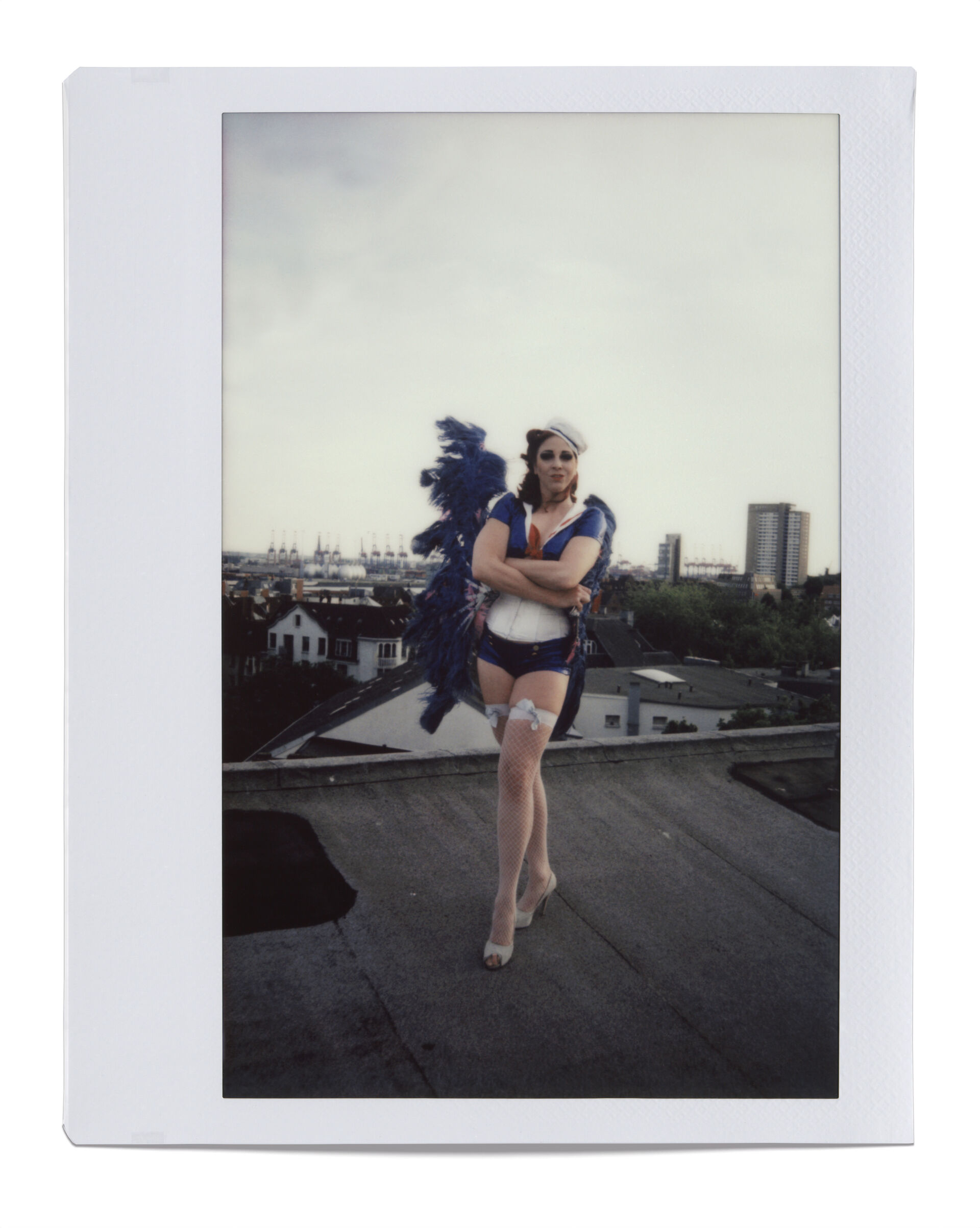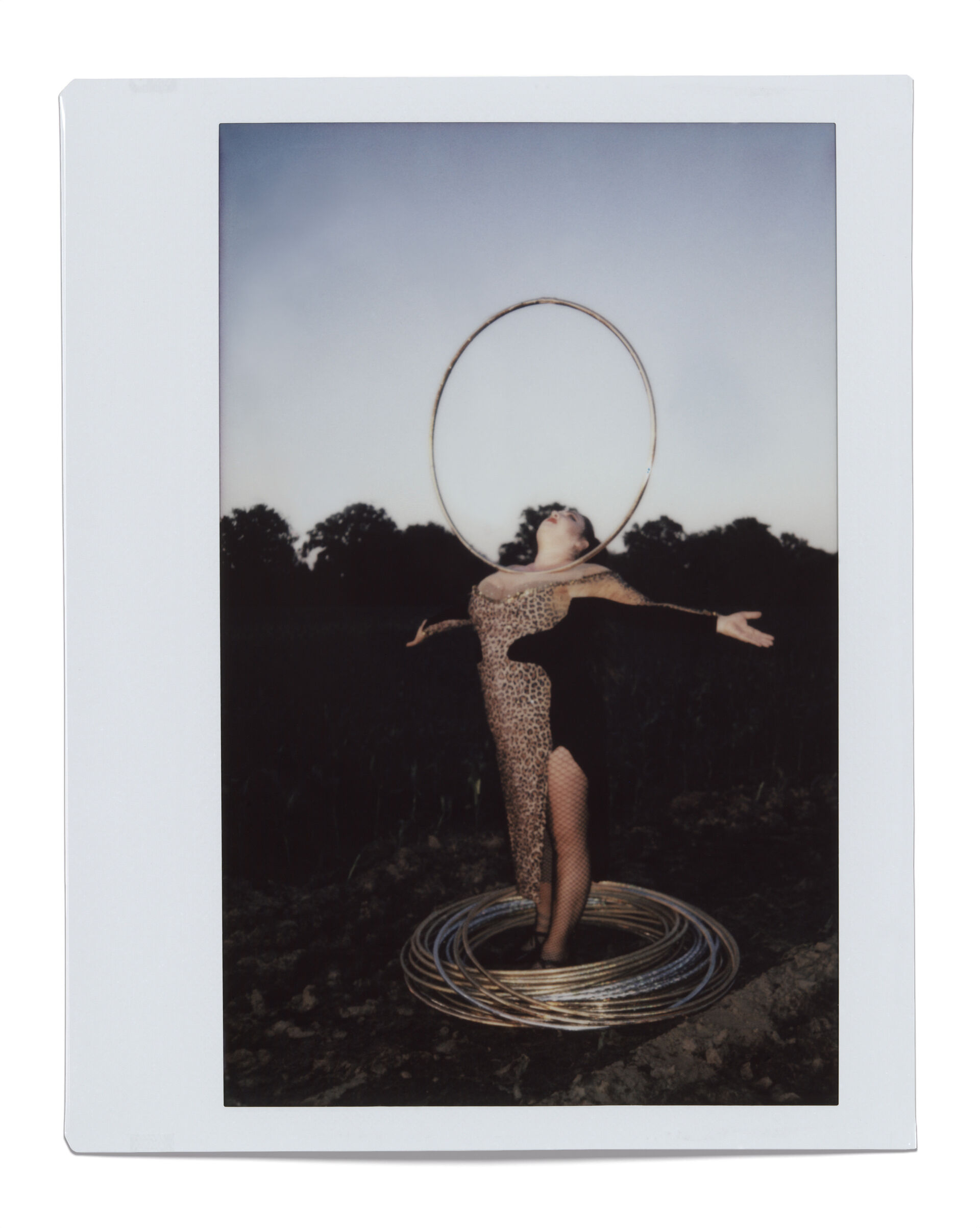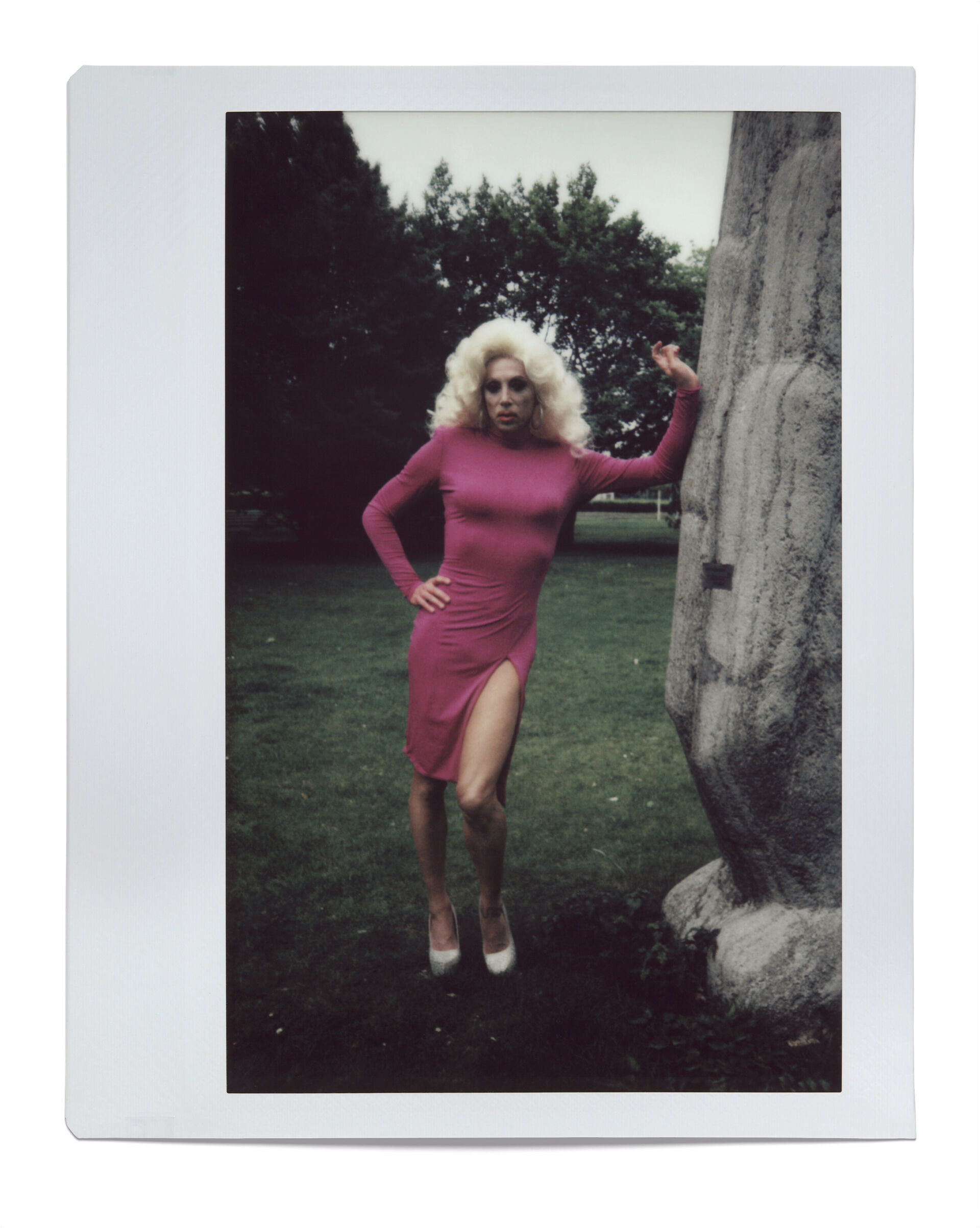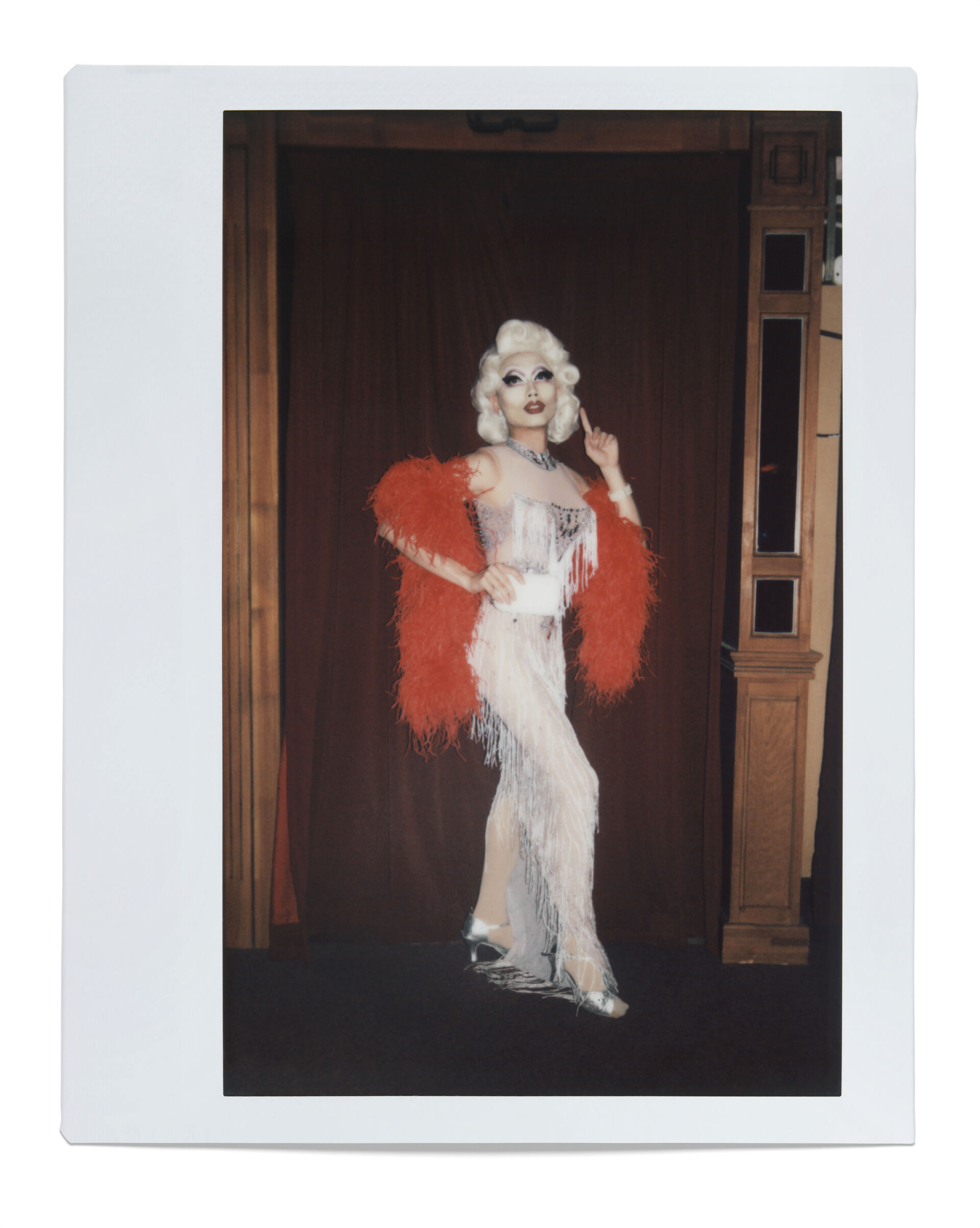
Wigs & Gloves, Performance by Uff, Triennial of Photography Hamburg 2022, Galerie Oel-Früh
Returning to 'Wigs & Gloves': Recounting my artistic interest in burlesque and drag
Editor's note: This contribution can be viewed together with the long read 'Erotic of Scholarship: On the place where birds can sing again' by Joanna Staśkiewicz, which deals more with the 'queer histories' of the burlesque and contextualizes Julia Gaes' so-called 'autoethnographic portraits'.
All images © Julia Gaes
Julia Gaes
28 nov. 2024 • 9 min
In collaboration with thirty artists from the fields of drag, burlesque, queerlesque, variety, cabaret, circus, belly dance and acrobatics, the artwork Wigs & Gloves was created between 2019 and 2022. In the following, I would like to tell you how I came into contact with these inspiring people as a photographer and how we conceived this work.

Wigs & Gloves - Eve Champagne
My work revolves around the exploration of body, gender, and identity – central themes that were also present in my earlier project The Naturists (2014–2018), in which I documented a group of nude hikers in their travels. Naturists try to get in touch with nature through their naked skin, and experience feelings of freedom, originality, and rebellion – an unusual form of protest in our digital age, in which nature seems ever more distant and in which nudity is constantly present in the media but seems to retreat more and more from everyday life into the private sphere. Nudist clubs in Germany have been in decline for years. The nude hiking movement, on the other hand, stands for free nudity without a club. But here, too, we see more (older) male participants than young women. Beauty ideals, sexism towards women in our society, and the development of protest culture in the digital world seem to be some of the reasons for the low number of new younger participants and especially women in the movement.
In my teenage years, long before I started studying photography, I had my first contact with burlesque when I saw a documentary about the burlesque scene in Hamburg on TV. Eve Champagne's powerful performance and elaborate costumes made a lasting impression on me. This experience sparked my long-standing interest in burlesque and drag.
Academic research in the field of burlesque, drag, and other forms of performance is quite rare, especially in German literature. I was very excited when I came across Jacki Willson’s book The Happy Stripper (2007) and, later, Joanna Staśkiewicz’s postdoc project ‘Queering of Gender, Desire and Local Myths in the New Burlesque’. I got in touch with Staśkiewicz and she wrote a text for the photobook that became Wigs & Gloves. Since burlesque is such a complex and interesting field, I was very happy to be able to bring the topic closer to the visitors to the exhibition and readers of the book. Together with the designers from Studio Mählerbrandt, we designed a book that combines all parts of the work: the Polaroids, the film, and the research on burlesque.

Wigs & Gloves - Marnie Scarlet
As Staśkiewicz has stated, from its beginnings at the end of the nineteenth century, burlesque can be regarded as a ‘queer performance’, as Lydia Thompson and the British Blondes were already cross-dressing in their shows.Joanna Staśkiewicz, ‘Queering in der (neo-)Burlesque’. Navigationen – Zeitschrift für Medien – und Kulturwissenschaften, 18, no. 1 (2018), 119-132. https://doi.org/10.25969/MEDIAREP/1890. Burlesque changed from a theatre performance into a strip and got especially famous in the 1920s, reaching Broadway in 1931.Robert Clyde Allen, Horrible Prettiness: Burlesque and American Culture (University of North Carolina Press, 1991). Although it enjoyed some success there, burlesque was driven off Broadway by critical religious voices and disappeared for a while. However, with the economic boom in the mid-1950s, everything American became highly regarded, and so burlesque returned. In the 1970s and 1980s, burlesque faced strong competition from the legalisation of pornography and the success of peep shows. In the context of the new permissiveness, burlesque seemed old-fashioned.
The flourishing of performance art led to a major comeback for burlesque in the mid-1990s, which continues to this day. Before the terms 'New Burlesque' or 'Neo-Burlesque' emerged and the performers reflected and named their performances as such, their performances were referred to as 'Performance Art', 'Female-to-Female Drag' or 'Creative Stripping'.Emily Layne Fargo, ‘The Fantasy of Real Women: New Burlesque and the Female Spectator’ (MA thesis, Ohio State University, 2008), 23. https://etd.ohiolink.edu/acpro... The new burlesque reclaimed the body as a symbol of self-determined eroticism and as a stage for political statements and provocations.Lucinda Jarrett, eds. Andrea von Struve and Petra Post, Striptease: die Geschichte der erotischen Entkleidung (Rütten & Loening), 1999.

Wigs & Gloves - Viktoria Lapidus
These self-designed performances work with different influences and quotes, drawing from the fashion of different centuries, music, pop culture, and art history and creating a new mix that sets these pieces into a new context. This was quite clear from the performances I attended: Giddy Heights mixed fashion from Marie Antoinette with music from Missy Elliot; Hasard le Sin started with a Victorian outfit and Hamlet’s skull but ended with a modern striptease. One of the recurring components is the vintage aesthetic of the 1920s or the Victorian era, which is used by various performers in their outfits, their music or their body movements.This aesthetic is often used in contrast to the modern parts of the performance. To translate this elements into my practice, I photographed the portraits on Polaroid. Since it’s an ephemeral medium, it will change over time – the colours will change, the images will blur. The format also refers to the card de la visite – cards used by the first burlesque artists in the mid-nineteenth century to present themselves.

Wigs & Gloves - Sherry Vine

Wigs & Gloves - The Ryan Stecken
In addition to the mix of body movements, music, fashion, and carnivalesque and cosplay elements, I noticed how the performers worked with the aesthetics and history of the place where they lived, or continued in their performances with styles that have shaped the art forms of vaudeville, such as Moulin Rouge, or the pin-up influences representing a 1950s American aesthetic. Staśkiewicz refers to this connection with the aesthetics of the performers’ cities as the ‘myths’ of burlesque.Staśkiewicz, ‘The New Burlesque as an Example of Double-Simulacrum’, 116–122. https://www.researchgate.net/p... The myths of the city flow into the performance as a ‘simulacrum’.According to Jean Baudrillard, a simulacrum is a copy, a copy without an original. Quoted by Staśkiewicz ‘The New Burlesque as an Example of Double-Simulacrum’, Forum Socjologiczne 8, no. 8 (2018), 116. See Baudrillard, Simulacra and Simulation (Ann Arbor, 1994). She describes the new burlesque as an “embodiment of the imaginations of gender roles, seduction and local authenticity”.Staśkiewicz, ‘The New Burlesque as an Example of Double-Simulacrum’, 116. Staśkiewicz examines this theme using the example of the cities of New Orleans, Berlin and Warsaw, cities in which the performers work with a variety of myths of their city: New Orleans with its red-light district Storyville and as the birthplace of jazz, as a diverse city with African, Creole and American culture and religious influences of christians and voodoo; Berlin with the myth of the Golden Twenties and the tradition of cabaret, but since the last decades also as a techno city; Warsaw working with Polish national catholic myths and polish history.Staśkiewicz, ‘The New Burlesque as an Example of Double-Simulacrum’, 116–122.

Wigs & Gloves - Lola la Tease
Other examples that have caught my eye are the Moulin Rouge in Paris; the port of Hamburg and the myth of the sailors and the ‘sinful mile’: the Reeperbahn in Hamburg’s St. Pauli district, where various pin-up illustrations can be seen. The pin-up girl and burlesque and their retro aesthetic often inspire each other. The Hamburg burlesque artist Eve Champagne works with this myth in her sailor costume. For my photographic work, I was inspired by these myths and the performances themselves. I photographed Eve Champagne on a rooftop in St. Pauli, with the harbour in the background. Lola La Tease lives in Berlin and works with the aesthetics of the 1920s: she wears a bob – the hairstyle of the modern woman in the 1920s – and a glamorous outfit, and the Polaroid was taken in the Wintergarten in Berlin, a variety theatre with a long history. Miss Setty Mois poses in front of a mill – her body continues the position of the wheels. Her elegant outfit is reminiscent of the Parisian variety theatres of the 1920s, as is the allusion to the Moulin Rouge in the background. As the location is always offstage, the idea of the performers' visibility continues. In various Polaroids, the performers merge into the background and the boundaries of gender blur.

Wigs & Gloves - Miss Setty Mois
I personally see burlesque as a movement that is part of the larger queer feminist movement in its first, second, and third waves. I decided to make a film in which the Polaroid portraits would resonate with those histories. The 16-mm film begins with a tableau vivant, which can be seen as a prefiguration of burlesque: an art form in which the performers recreate a painting or sculpture on stage without moving. Drag queen Uff breaks out of this silent position and begins a performance of her own choosing.
Wigs & Gloves, 16 mm film / 2:45 min loop projection

Wigs & Gloves, 16 mm film / 2:45 min loop projection
Installation View, Triennial of Photography Hamburg 2022, Galerie Oel-Früh
Uff played on the historical painting Grande Odalisque (1814) by Jean-Auguste-Dominique Ingres, which was used by the Guerrilla Girls in Do Women Have to Be Naked to Get into the Met. Museum? (1989) to draw attention to the discrimination against women in the art world. Various quotes from feminist artworks and feminist online movements can be seen in the film, remixed and recontextualized, as in the performances of the burlesque artists. To name just a few: the vulvar plates of Judy Chicago's Dinner Party (1974–1979) and the online movement against the taboo of menstruation. The loop of the film in its beginning and end shows an up and down, which refers to the breaks in the queer feminist movement.
Looking back on the last few years of working on this project, I am very happy about the people I have met and worked with. Their great diversity in art, performance and science has inspired me a lot and made me grow personally.
- - - - - - -
Wigs & Gloves (2019–2022)
Thirty-two Polaroids in object framing of Asha Jones, Marlene Kiepke, Hasard le Sin, Kanae Mito, UFF, Lola la Tease, Betty Fvck, Giddy Heights, Marnie Scarlet, Theodora Rex, Dave The Bear, Lucy Lovegun, Lexy Nightcat, Arden Delacour, Miss Setty Mois, Viktoria Lapidus, Sherry Vine, The Ryan Stecken, Bonnie Boux, Darvish, La Viola Vixen, Seymour Bottoms, Miss Rudy Ruby, The Electrik Poodles, Alexander the Great, Felicia Diamond, Eve Champagne, Velvet Rose, Tristan Ginger and Chlorophyll von Needle.
Film: 16-mm film / 2:45-min loop projection: Uff (performance), Georg Müller (DOP), Michelle Müller (set design)
Book: text by Joanna Staśkiewicz; design by Mählerbrandt
Performance: various performance artists


Wigs & Gloves is an artwork with thirty-two Polaroids of performers from the fields of drag, burlesque, queerlesque, variety, cabaret, circus, belly dance, and acrobatics. The images show different performing arts, as the group is very diverse, and the different performing arts often work together and merge into each other. The artwork includes the exhibition of the Polaroid images and a 16-mm film with a performance by drag queen Uff, a book containing the Polaroid images, contact sheets of the 16-mm film, and a text by researcher Joanna Staśkiewicz, as well as performances in the exhibition by various performance artists pictured on the Polaroids. The work questions and breaks with gender norms and supports the visibility of different gender and queer identities.
PURCHASE THE BOOK HERE.

